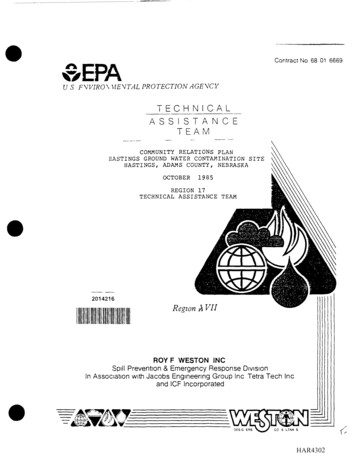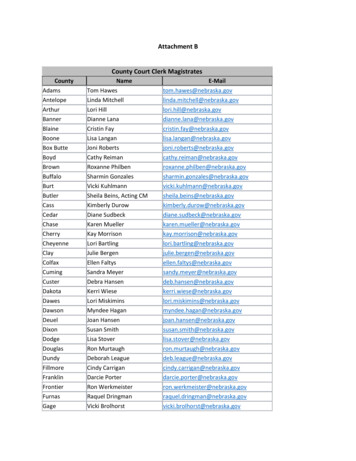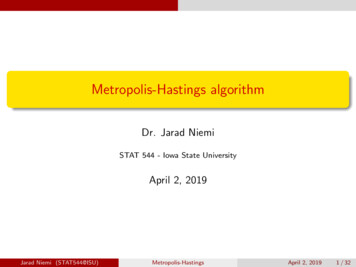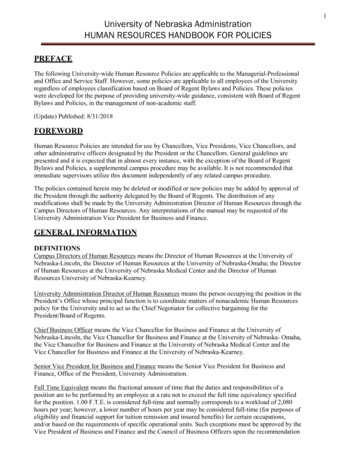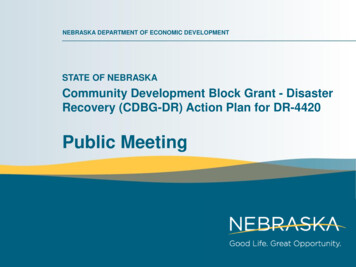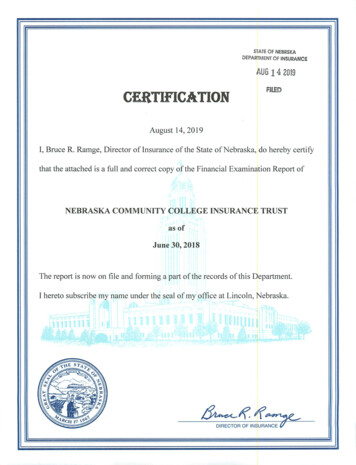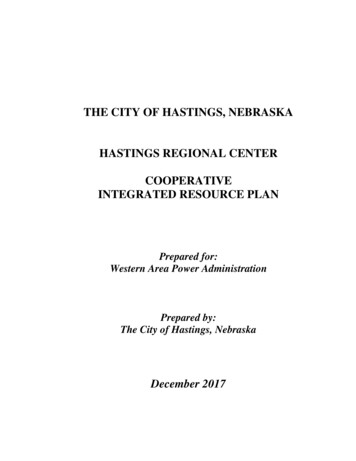
Transcription
THE CITY OF HASTINGS, NEBRASKAHASTINGS REGIONAL CENTERCOOPERATIVEINTEGRATED RESOURCE PLANPrepared for:Western Area Power AdministrationPrepared by:The City of Hastings, NebraskaDecember 2017
Cooperative Integrated Resource PlanTABLE OF CONTENTSPage No.1.0 Background Information22.0 Profile22.1The City of Hastings, Nebraska (Hastings)22.2Hastings Regional Center (HRC)43.0 Existing Supply System53.1.0Hastings3.1.1 Whelan Energy Center 1 (WEC 1)3.1.2 Whelan Energy Center 2 (WEC 2)3.1.3 North Denver Station (NDS)3.1.4 Don Henry Power Center (DHPC)3.1.5 Station Operating Modes and Capacity Factors3.1.6 Purchase Power Agreement with WAPA3.1.7 Historic and Projected Fuel Prices3.1.8 Physical Assessment of the NDS Generating Units3.1.8.a Steam Turbine Generator3.1.9 Regional Reliability Organizations5567889101212133.2.0HRC3.2.1 WAPA Purchases3.2.2 Generation Facilities3.2.3 Supplemental Power Purchases141414154.0 Environmental Considerations154.1.0Hastings4.1.1 Title IV Nox Requirements4.1.2 Title IV SO2 Requirements4.1.3 Title V Requirements4.1.4 Mercury and Air Toxics Standard Rule (MATS)4.1.5 WEC 2 Environmental Controls1515161718194.2.0HRC19
Cooperative Integrated Resource PlanTABLE OF CONTENTScontinued5.0 Conversion/Demand Side Management Programs195.1.0Hastings5.1.1 LED Street Light Conversion5.1.2 Excess Power Sales5.1.3 Public Information Programs5.1.4 Customer Energy Incentive Plan5.1.5 Interruptible Irrigation Load5.1.6 Alternate Powering for Water Wells5.1.7 Miscellaneous System Efficiency Enhancements19192020212122225.2.0HRC5.2.1 Energy Efficient Heat and Air Conditioning5.2.2 Water Supply2222226.0 Recent and Projected Load Growth236.1.0Historical Retail Sales and Peak Demand - Hastings6.1.1 Forecasts of Peak Demand Growth6.1.2 Forecasts of Retail Energy Sales2325266.2.0Historical Peak Demand - HRC6.2.1 Projected Peak Demand - HRC29297.0 Capacity and Energy Situation307.1.0Scenarios of Need for Capacity7.1.1 Base Case Scenario30307.2Energy Sources and Uses328.0 Nebraska Power Association – Statewide Plan339.0 Public Participation Process349.1Hastings349.2HRC34
Cooperative Integrated Resource PlanTABLE OF CONTENTScontinued10.0 Renewable Energy Options10.1 Hastings Wind Energy11.0 Implementation Plan35353611.1Hastings3611.2HRC36Attachment 11-137Attachment 11-239
1.0 Background InformationAs long time customers of the Western Area Power Administration (WAPA), theCity of Hastings, Nebraska (Hastings) and the State Building Division, Hastings RegionalCenter (HRC), have previously completed Conservation and Renewable Energy Plans(C&RE) in accordance with Title II of the Hoover Power Plant Act of 1984.The Energy Policy Act of 1992 and the WAPA adoption of the Energy Planningand Management Program, requires that all WAPA customer’s holding long-term firmpower resource commitments complete an Integrated Resource Plan (IRP), in an effort topromote efficient use of electric energy by Western customers. As HRC’s distributionsystem is totally surrounded by and interconnects with Hastings’ system, a request wassubmitted to WAPA in December, 1995 to allow HRC and Hastings to submit acooperative IRP. Hastings and HRC received authorization from WAPA on January 23,1996 to file a cooperative IRP including information for both entities. Hastings and HRCsubmit the following cooperative IRP in accordance with WAPA requirements.2.0 Profile2.1 The City of Hastings, Nebraska (Hastings)Hastings operates a publicly owned, full service municipal utility providingelectrical, natural gas, water, sanitary sewer and street lighting service to the city ofHastings, Nebraska and surrounding areas. Hastings has provided at least one utilityservice since its inception in 1886, when municipal ownership and operation of the waterand sewer system began. The electric system began to evolve in the early 1900’s, andcurrently includes a service area of approximately 57 square miles. The natural gassystem became publicly owned in 1942.Today, Hastings provides reliable, economical utility service to nearly 13,325electric customers, 10,700 natural gas customers and 9,900 water and sewer customers.Power is primarily provided by the locally-owned 76 megawatt (MW) net, coal-firedGerald T. Whelan Energy Center 1 (WEC 1). Supplementing the WEC 1 are severaladditional generation facilities. The Whelan Energy Center 2 (WEC 2), a coal-fired 220net MW generation facility that began commercial operation in 2011, is owned by thePublic Power Generation Agency (PPGA) with Hastings having a 35 MW ownershipshare that is currently partially assigned to two other entities through April 2018. The2
Cooperative Integrated Resource PlanDon Henry Power Center (DHPC) is a dual fuel gas turbine which operates on eithernatural gas or distillate oil. The North Denver Station (NDS) has two dual fuel steamturbine generators which can operate on either natural gas or No. 2 distillate oil. Total2016 output of Hastings’ generation facilities was 170 MW. Hastings also receives 11.4MW, during peak periods, of WAPA generation. The electrical system had retail sales ofnearly 404,184 MWh in 2016 with a peak hour usage of 92.0 MW on July 21, 2016.Wholesale power sales to the SPP Integrated Market accounted for an additional 89,440MWh in 2016.Utility operations at Hastings are overseen by an advisory Utility Board thatmakes recommendations for approval on utility matters to the locally elected CityCouncil. The Utility Board was appointed in May 2017 and replaced a previous Board ofPublic Works. The Utility Board has five members who are recommended to the CityCouncil by the Mayor. Each year, one board position is up for reappointment orreplacement. Utility Board terms are for five years.In the early years of the electric system, coal was the primary fuel used to fuel theboilers. Natural gas took the place of coal in 1941. With the onset of the energy crisis inthe mid 70’s, Hastings learned from its gas supplier that natural gas would be phased outas a viable boiler fuel by 1979. This prompted the community decision makers toinvestigate all available energy options. A study examining all available energy optionsculminated in a decision to build the 77 MW WEC 1 coal-fired plant east of town, whichbecame operational in 1981. In 2001, Hastings contracted with an outside consultingagency to complete a Power Supply Study, to provide Hastings with the economics ofpower supply alternatives. As the result of that study, Hastings joined four other utilitiesin building a 220 MW coal fired plant (WEC 2) at the current WEC 1 plant location eastof town. WEC 2 went on line commercially May 1, 2011.The easing of the natural gas shortage and the resulting ability to again utilizenatural gas as a boiler fuel provides a significant amount of unused generation capacity inHastings. Although the cost of energy generated on natural gas (and backup oil supplies)has historically been at a higher dollar cost than coal, the availability of excess generatingcapacity has provided operational and financial benefits to Hastings. The availability ofexcess capacity has allowed for load planning flexibility. As Hastings’ peak energy needshave increased, available capacity has existed to meet those needs. The rate payers ofHastings have also benefited from the revenues derived from marketing excess capacityand associated energy to third parties. Hastings is currently experiencing an excess3
Cooperative Integrated Resource Plangeneration position, and with the building of WEC 2, Hastings will have excess capacityat least until the year 2031 using current growth estimates.2.2 Hastings Regional Center (HRC)The Hastings Juvenile Chemical Dependency Program (HJCDP) providesresidential substance abuse treatment for adolescent males from the ages of 13 to 18years. The average length of stay is approximately 3-4 months, and utilizes evidencedbased practices including motivational interviewing, various cognitive behavioral therapyapproaches, contingency management, medication assisted treatment and Brief StrategicFamily Therapy. The Hastings Regional Center is a Joint Commission accredited facility.The HRC will undergo major revisions to the campus in the next few years.Currently, a new project is underway to relocate the youth from the HJCDP into threenew buildings located on a vacant site just to the south of the current Building #3 on theHRC campus. The new buildings will include two housing buildings and one largerbuilding to provide education, treatment and dining services for the youth. The newbuildings are planned to be slab on grade, wood framed structures with residential typeconstruction methods that will perform more efficiently than the existing buildings.Following the construction of these new buildings, existing Building #3 will bedecommissioned and demolished.The present electrical system is currently a primary metered system located in theexisting boiler plant and is distributed to all the current buildings. The current plan toremove the boiler plant facility and construct new buildings will require an upgrade to theexisting electrical distribution system. The State Building Division is currentlyperforming a study to determine if it is financially beneficial to keep the primary systemor turn it over to Hastings. The Administration Building and the Chapel currently have asource of heat from the boiler plant and with the scheduled removal of the boiler plant thetwo facilities will need a new source of heat and cooling. One of the current 309 TaskForce projects is to install a new standalone heating and cooling system for theAdministration Building and the Chapel. The Administration Building and Chapel areplanned to be converted to an HVAC system utilizing geothermal wells. The new HVACsystems of the three new buildings are also planned to be heated and cooled bygeothermal wells. With new construction techniques and flexibility in the space layout,the updated facility will be more efficient from an energy, maintenance and staffingperspective. All new construction is anticipated to be completed by May of 2019.4
Cooperative Integrated Resource PlanThe HRC will also be connected to the Hastings water system within the nextyear. This will reduce the energy needed to supply water to the campus by reducing theuse of the well pumps. The existing wells will no longer provide potable water to thebuildings but may be used for watering the green spaces in the future.3.0 Existing Supply System3.1.0 HastingsHastings’ owns and operates three power stations with a combined rated capability of135 MW’s, and is the operator of the WEC 2, 220 MW coal station of which Hastingsowns a 35 MW share (total rated generation capability of 170 MW). The capability and fuelmix of the generating capacity at each site is summarized in Table 3-1. The power stationsare individually summarized in the following subsections.Table 3-1Summary of Hastings Utilities Existing Power StationsStation & Unit No.Whelan Energy Center 1Whelan Energy Center 2Don Henry Power CenterNorth Denver Station #4North Denver Station #5In-Service Primary FuelYear19812011197219571967SubBit. CoalSubBit. CoalNatl GasNatl GasNatl GasTOTALRated CapabilityMW76.035.0*18.015.025.0170.0Note: SubBit. refers to sub-bituminous, a medium heat content coal.Note *: Hastings’ share is 35 MW of the 220 MW rated plant but a portion of that isassigned through 2018.3.1.1 Whelan Energy Center 1 (WEC 1)The WEC 1 is a single-unit coal-fired power station located just east of the City limits,within Adams County. In 1988, Hastings sold a 6.95% participation share of WEC 1 to theMunicipal Energy Agency of Nebraska (MEAN) which is approximately 5.3 MW’s for the5
Cooperative Integrated Resource Planlife of the plant. The WEC 1 station includes a General Electric (GE) turbine-generatorwith a rated gross output of 83.6 MW, and a tangentially-fired, dry-bottom CombustionEngineering steam generator. The station includes an electrostatic precipitator for captureof fly ash. Cooling water for the station is provided by on-site wells, with a double flow,induced-draft cooling tower.The WEC 1 station burns low sulfur western coal from the Powder River Basin ofWyoming. Coal is shipped to WEC 1 in unit trains containing approximately 135 railcars.A continuous emission monitoring system was installed at WEC 1 in 1995. Hastingscurrently has surplus SO2 allowances that will allow the unit to operate as a base load unit.The impacts of Title IV of the 1990 Clean Air Act Amendments (CAAA) on the WEC 1station are further discussed in Section 4.Hastings currently sells approximately 40,000 tons of coal per year from the WEC 1coal yard to an ethanol production facility directly across the roadway from the WEC 1station. This ethanol plant is not a retail electric customer of Hastings.Hastings has an agreement that started in 2008 with a soy bean processing plant that isapproximately ½ mile from the WEC 1 station to sell them approximately 70,000 tons ofcoal annually. This ethanol plant is currently a retail electric customer of Hastings.3.1.2 Whelan Energy Center 2 (WEC 2)On October 25, 2006, the Public Power Generation Agency (PPGA) was formed underthe Interlocal Cooperation Agreement Act of the State of Nebraska to construct and operateWEC 2; a 220 MW net coal fired electric generating plant located on property adjacent tothe existing WEC 1 facility. The five participant members of PPGA are HeartlandConsumers Power District – 80 MW share (HCPD); Municipal Energy Agency of Nebraska– 80 MW share (MEAN); City of Grand Island Utilities – 15 MW share (GI); Nebraska CityUtilities – 10 MW share (NCU); and Hastings – 35 MW share.The WEC 2 stationincludes a GE turbine-generator with a rated gross output of 246 MW, and a Babcock &Wilcox (B&W) wall fired steam boiler. The station includes an electrostatic precipitator toremove fly ash, a scrubber to remove sulfur dioxide, selective catalytic reduction to reducenitrous oxides, and a baghouse for additional particulate removal, as well as mercuryremoval controls. WEC 2 is well-positioned to meet many existing and potential future6
Cooperative Integrated Resource PlanEPA environmental rules. Cooling water for the station is provided by on-site wells, with adouble flow, induced-draft cooling tower.The WEC 2 station burns low sulfur western coal from the Powder River Basin ofWyoming. Coal is shipped to WEC 2 in unit trains containing approximately 135 railcars.Hastings has entered into agreements with HCPD and with MEAN for the partialtemporary assignment of energy resources from WEC 2 as Hastings did not anticipateneeding its entire 35 MW share to meet local load needs during the early years of WEC 2operation. The following schedule outlines the dates and increments of returningmegawatts to Hastings since WEC 2 began commercial operation:Hastings ShareMay 2011 through April 20135 MWMay 2013 through April 201410 MWMay 2014 through April 201515 MWMay 2015 through April 201620 MWMay 2016 through April 201725 MWMay 2017 through April 201830 MWMay 201835 MWWEC 2 currently participates in the Southwest Power Pool (SPP) Integrated Market(IM). Tenaska Power Services and MEAN are the two Market Participants (MP’s) thatrepresent the five owners of WEC 2 in the SPP IM market.3.1.3 North Denver Station (NDS)NDS is Hasting's original power station, co-located with utility offices and operationalfacilities in the north central portion of Hastings. Units 4 and 5 at NDS were installed in1957 and 1967, respectively, and continue to be operated by Hastings. Boilers for theoriginal generating units 1 through 3 have been removed from the site. The associatedturbine-generator #3 has been sold. Turbine #1 and #2 remain retired in place.The primary fuel at NDS is natural gas, with No. 2 distillate oil currently applied asbackup fuel. One distillate fuel oil storage tank is currently on site, with a total capacity of580,000 gallons.7
Cooperative Integrated Resource PlanNDS Unit 4 includes an Allis-Chalmers turbine-generator and a Springfield steamboiler. The capacity of NDS Unit 4 is 15 MW. Turbine inlet temperature and pressure are900 F and 850 psi, respectively. The Unit 4 condenser is cooled by a once-through watersystem, drawing water directly from dedicated wells.NDS Unit 5 includes a GE turbine-generator and a B&W steam boiler. The capacity ofNDS Unit 5 is 25 MW. Turbine inlet temperature and pressure are identical to Unit 4. TheUnit 5 condenser is cooled by a mechanical draft cooling tower, with water supplied bywells.At present, Units 4 and 5 are generally only operated for a few weeks in the summermonths for testing. They are also available in the SPP IM if market conditions warrant forthem to be called upon. There is generally one operator on duty per shift, who also servesas system dispatcher. More operating personnel are generally assigned to the station whenWEC 1 is shut down and in summer operating months.3.1.4 Don Henry Power Center (DHPC)The DHPC includes a GE Frame 5 combustion turbine generator and an electricalsubstation located in the southwest portion of Hastings. The capacity of DHPC is 18 MW.Primary fuel for the station is natural gas, with distillate oil as backup fuel. The DHPC siteincludes two oil storage tanks with a combined capacity of 296,000 gallons.There is sufficient physical space at the DHPC site for a second Frame 5 or Frame 6combustion turbine generating unit. Fuel is provided to DHPC from a Tallgrass InterstateGas Transmission (TIGT) natural gas town border station (formerly Kinder Morgan), a fewhundred yards from the DHPC site. The pipeline from the TIGT town border station toDHPC is sufficient to support concurrent operation of two generating units at the site.However, the TIGT supply line is insufficient to support operation of the existinggenerating capacity at DHPC during peak natural gas usage months in the winter season.3.1.5 Station Operating Modes and Capacity FactorsThe WEC 1 station is on-line most hours of the year, and provides the bulk of electricenergy for Hastings' retail customer load. NDS and the DHPC units are generally availablefor the SPP IM if called upon, however, the NDS units typically operate only several weeks8
Cooperative Integrated Resource Planper year and then, primarily for testing. The DHPC station is available to be called on bythe SPP IM when needed. HU also completes a monthly operational test on DHPC. Priorto the SPP IM, with the high price of natural gas it had been more economical for Hastingsto purchase energy from outside sources to cover local load rather than operate either NDSor DHPC. In the last few years with the lower natural gas prices and the addition ofrenewable energy resources in the SPP footprint, it has put downward pressure on the priceof energy. Thus, the WEC units have often been dispatched by the SPP IM to minimumoperational levels during shoulder months and off peak hours. The NDS and DHPC unitshave seldom been called upon by SPP due to low alternative energy prices. Table 3-2summarizes the annual capacity factor of each station for the past five years.Table 3-2Annual Capacity Factor of Hastings' Power StationsYearStation20122013201420152016Whelan Energy Center Unit 153.5664.3466.1847.99 50.46Whelan Energy Center Unit 252.2770.2357.5855.17 47.30North Denver Station (2 units)0.42.160.120.130.10Don Henry Power Station0.270.050.030.040.05Note 1: Capacity factors based on rated capacity of Table 3-1, and net energyoutput (NDS and DHPC calculations generally exclude on-site use in monthswith no gross generation). Capacity factor equals energy generated dividedby total hours in the year.Note 2: Whelan Energy Center Unit 2 began commercial operation on May 1, 20113.1.6 Purchase Power Agreement with WAPAHastings has a long-term agreement with WAPA that provides capacity and energy toHastings. The firm capacity provided by WAPA in the summer and winter seasons issummarized in Table 3-3. WAPA reduced Hastings firm capacity by 1.0 percent in 2006.WAPA has the option starting in 2011 to reduce firm capacity by 1.0 percent by providingtwo years advance notice. WAPA has the further option to reduce Hastings' firm capacityallocation by 5.0 percent for new project use requirements by providing at least five yearswritten notice.9
Cooperative Integrated Resource PlanTable 3-3Firm Capacity Provided to the City of Hastings by WAPA (MW)Summer Seasons11.360Winter Seasons6.189Note:Summer months are defined as May through October.Seasonal energy guaranteed to be provided by WAPA under the contract is based on adefined portion of Hastings' system energy requirements. WAPA currently providesapproximately 27,509 MWh in the summer season and 19,641 MWh in the winter season(total 47,150 MWh annually).3.1.7 Historic and Projected Fuel PricesFuel prices for each of the existing stations for the past four years are summarized inTable 3-5. Coal fuel prices have steadily increased during this time period, primarily due toincreases in rail transportation costs. Natural gas prices increased through 2014 but starteddecreasing in 2015 and have continued to decline into 2016. Since 2016 prices of naturalgas have started moving upwards. According to the Energy Information Administration(EIA) the forecasted natural gas prices will continue to increase thru at least 2020.Coal and natural gas delivered fuel price forecasts applied are illustrated on Figure 3-1,and detailed in Table 3-4. Hastings rail contract is currently a five year contract that willexpire on 12/31/2018. Hastings coal contract currently is a two year contract that willexpire on 12/31/18. The 2017 coal cost is lower than 2016 primarily because of favorablecoal supply contracts that were obtained from suppliers due to the uncertainty that existed inthe coal industry as a result of proposed EPA legislation by the prior politicaladministration. Base coal price forecast according to the ”EIA 2017 Annual EnergyOutlook” report is projecting that Western coal prices will increase an average of 0.5%through 2035.The forecasted values for natural gas prices, shown in Figure 3-1 and Table 3-4, areannual values calculated as the average of projected monthly values. The average annualnatural gas delivered price in 2017 is estimated to be about 2.99 per MMBtu.10
Cooperative Integrated Resource PlanTable 3-4Forecasts of Coal and Natural GasAs-Consumed Fuel 2027Coal*Percent 1.7831.9%Natural Gas**Percent .5%*2017 is based on actual prices through Oct; 2017 isbased on coal & rail bids; 2018 - 2027 is using theexisting 2017 price and increasing the coal costby the EIA avg of 0.5% and rail costs by 2.5%**EIA AEO 2017-2027 forecasted Henry Hub spot priceTable 3-5Annual Fuel Cost of Hastings' Power Stations ( /MMBtu /106 Btu)StationYearWhelan Energy Center (2 units)North Denver Station (2 units)Don Henry Power 11.563.773.961.553.383.32Fuel prices are based on higher heating value (HHV). Whelan Energy Centerincludes both WEC-1 and WEC-2.11
Cooperative Integrated Resource PlanFigure 3-13.1.8 Physical Assessment of the NDS Generating UnitsUnits 4 and 5 at NDS were installed in 1957 and 1967, respectively. Both generatingunits were operated in base-load mode until 1981, when the WEC 1 station becameoperational. Since that time, the units have been operated intermittently for peaking andreplacement power. During this time, the generating units have typically operated severalweeks each year. As a result, Units 4 and 5 have been operated the equivalent ofapproximately 25 and 15 years, respectively.The general condition of the balance of station equipment for Unit 5 is better than thatof Unit 4. This would be expected, as Unit 5 is newer and has fewer operating hours.3.1.8. a Steam Turbine and GeneratorUnit 4 turbine generator was overhauled in 1998. Unit 5 turbine generator wasoverhauled in 1999. Generator retaining rings were replaced on both units during theoverhaul. Both units were found to be in good shape.12
Cooperative Integrated Resource Plan3.1.9 Regional Reliability OrganizationsIn 1996, Hastings became a member of the Mid-Continent Area Power Pool (MAPP).MAPP comprised a multi-state region in the north-central U.S., including the entire state ofNebraska. Membership in MAPP provided Hastings an interface with the larger powersuppliers in the region.The MAPP members operated a wholesale market for the voluntary purchase and saleof electricity at market-based rates, exchanged real-time system cost information, providedmaintenance and emergency backup power to each other's power systems, and otherwisecoordinated transactions and operation of the regional electric system.In 2002, MAPP merged its operations with the Midwest Independent TransmissionSystem Operator (MISO). MISO’s primary role was to ensure equal access to thetransmission systems for all participants and selling transmission service on those linesunder FERC tariffs.With the increasing emphasis on system reliability, MAPP created the MidwestReliability Organization (MRO) to address those concerns. The MRO is a non-profitorganization dedicated to ensuring the reliability of the bulk power system in the NorthCentral part of North America. The primary focus of the MRO is ensuring compliance withregional reliability standards and criteria utilizing open, fair process in the public interest.On January 1, 2005 this organization became operational and replaced the MAPP RegionalReliability Council of the North American Electric Reliability Council (NERC). The MROmembership is comprised of municipal utilities, cooperatives, investor-owned utilities, anda federal power marketing agency, Canadian Corporations, and independent powerproducers.Hastings sent written notice to withdraw from MAPP effective April 1, 2009 andHastings became a transmission customer of the Southwest Power Pool (SPP). SPP is aRegional Transmission Organization (RTO), mandated by the Federal Energy RegulatoryCommission (FERC) to ensure reliable supplies of power, adequate transmissioninfrastructure, and competitive wholesale prices of electricity. As a NERC Regional Entity,SPP oversees compliance enforcement and reliability standards development. The SPPIntegrated Marketplace (IM), which went live in 2014, includes a Day-Ahead Market withTransmission Congestion Rights, a Reliability Unit Commitment process, a Real-Time13
Cooperative Integrated Resource PlanBalancing Market that replaced the Energy Imbalance Service Market, and the incorporationof price-based Operating Reserve procurement. SPP is currently the Consolidated BalancingAuthority (CBA) and will balance supply and demand for the region, maintain frequency,and maintain electricity flows between adjacent BA’s. SPP membership is comprised ofcooperatives; independent power producers; independent transmission companies; investorowned utilities; marketers; municipals; and state agencies. Hastings has contracted with athird party, Tenaska Power Services, to represent Hastings as its Market Participant (MP) inthe IM.3.2.0 HRC3.2.1 WAPA PurchasesThe vast majority of energy used at HRC is supplied through its WAPA purchasecontract. The WAPA energy is delivered to the Hastings’ interconnect with the NebraskaPublic Power District (NPPD) and is “wheeled” over Hastings’ system to HRC. TheContract Rate of Delivery (CROD) for firm power until October 31, 2015, under the WAPAcontract was 790 kW during the Winter Season and 1,433 kW during the summer season.On November 1, 2015, HRC transferred a portion of its allocation to the Nebraska StatePenitentiary in Lincoln, Nebraska. The HRC Winter CROD was reduced to 316 kW for theWinter Season and 737 kW for the Summer Season. This reduction in CROD’s wasadequate to supply peak period to date. The peak electrical demand at HRC during the pastthree years was in July, 2016, when a daily peak of 651 kW’s occurred. The daily CRODtotally satisfied this peak day requirement. Peak annual energy use during the past threeyears occurred during the period of January 2015 through December 2015 when over 2,437MWH’s of power was consumed. Of this amount, all was provided by WAPA.3.2.2 Generation FacilitiesA 750 kW steam powered turbine-driven generator is currently located at HRC. Thisgenerator has not been operated for over 25 years. With the major renovations scheduled tooccur in the next few years, this steam powered turbine driven generator will be removedwhen renovations have been completed.14
Cooperative Integrated Resource Plan3.2.3 Supplemental Power PurchasesHRC currently has a Supplemental Purchase Power Agreement with Hastings in theevent WAPA power delivered is inadequate to supply HRC’s entire needs. Due to thedirect interconnect with Hastings’ system and the excess capacity/energy position ofHastings, supplemental power is readily available at an agreed upon rate if needed byHRC.4.0 Environmental Considerations4.1.0 HastingsThis section summarizes the impact of Title IV of the Clean Air Act on existing andfuture generating capacity owned by Hastings. Also summarized are related proposedregulations that are under consideration.4.1.1 Title IV NOx RequirementsUnder Title IV of the Clean Air Act Amendments (CAAA) of 1990, all coal-fueledboilers are required to meet specific NOx emission levels. Under the CAAA regulations,the boiler at WEC 1 qualifies as a "Phase II" boiler, required to meet a NOx emissions limitof 0.38 lbs/MMBtu as of January 1, 2000. Hastings elected early participation in the TitleIV NOx program, resulting in an emission limit of 0.45 lbs/MMBtu applying until January1, 2008. The required NOx emission limit for WEC 1 red
cooperative IRP. Hastings and HRC received authorization from WAPA on January 23, 1996 to file a cooperative IRP including information for both entities. Hastings and HRC submit the following cooperative IRP in accordance with WAPA requirements. 2.0 Profile . 2.1 The City of Hastings, Nebraska (Hastings)




